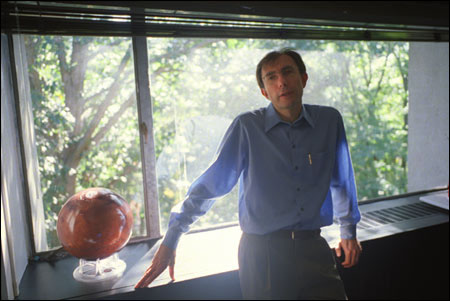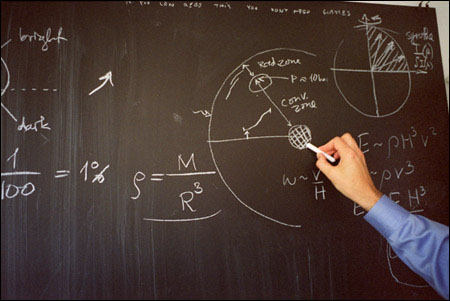Finding the hot planets beyond our solar system
Dimitar Sasselov looks for alien worlds

Dimitar Sasselov did what every high school astronomer dreams of doing; he went from looking at stars with a backyard telescope to discovering a new class of planets and a new class of stars.
Two years ago, Sasselov led a team that sighted the most distant planet ever found in the Milky Way, a gigantic ball of gas in the constellation Sagittarius. Such immensities are now called “very hot Jupiters,” because their atmospheres are hot enough to melt iron and they are as big as or bigger than the largest planet in our solar system.
Sasselov, now 43, often thinks back to his boyhood in Bulgaria when he used a small telescope to gaze at the many moons that orbit Jupiter. That telescope turned out to be his ticket to a Ph.D. from the University of Toronto and a tenured professorship at Harvard, granted this year.
Here, he pioneered a new technique to find alien planets. Beginning about 1995, planets beyond the sun were detected by what could be called the “wobble” method. When a planet whirls around its star, gravitational tugging causes the star to wobble. That’s a difficult thing to spot, but large telescopes and precision measuring instruments now make it possible.

Sasselov and his colleagues developed a different technique that might be called the “winking” method. When planets pass across the faces of their mother stars, they dim the twinkle a bit. Again, it requires huge telescopes and the best light detectors on Earth, but, as Sasselov showed, it can be done. He compares identifying his first out-of-the solar system Jupiter to “spotting a mosquito flying in front of a searchlight 200 miles away.” (See Jan. 16, 2003, Gazette).
Jupiter, god of light, was the chief Roman god. Instead of being named for a mythical god, however, this new gargantuan was given the incomprehensible appellation OGLE-TR-56. To demonstrate that this was not just a one-time bull’s-eye, Sasselov’s team found another hot Jupiter with the so-called transit method. The existence of this new planet class was further confirmed by a Swiss-French group that ogled another torrid OGLE using the wobble method.
For planet finding, winking has an advantage over wobbling. “The transit method not only discovers planets for you, it lets you measure their size,” Sasselov notes. That’s important when you search for other worlds the size of Earth. Very hot Jupiters, and the other 100 or so extrasolar plants found to date, can’t support life of an earthly kind. They’re too hot. Every wobbler and winkler now wants to be first to find a planet more likely to be lively.
Sasselov notes that “the two methods are complementary not exclusive. We are in a friendly competition with each other.”
A halo of stars
Growing up in Bulgaria, his father, an archaeologist, and his mother, a horticulturist, pushed Sasselov toward science. “They were trying to keep me out of trouble,” he recalls. “These were times of communist rule, and you didn’t need special privileges to study science as you did for more politically sensitive subjects like journalism or law.” Even Stalin liked physics.
After his father bought him a small telescope, young Dimitar enjoyed observing the moons of Jupiter and making models of their orbits. He was also good at and excited about physics and mathematics, astronomy’s first cousins.
While attending a high school summer astronomy camp, Sasselov says, “I stumbled across a new type of star living in the halo of old stars that surround the Milky Way.” He continued to study these stars at the University of Sofia. A paper he wrote about them attracted the attention of his mentors. They arranged to have it published outside Bulgaria, something not easy to do from the Communist world in the 1980s.
The paper attracted enough attention at the University of Toronto for that school to offer him a graduate scholarship. However, he didn’t have the connections needed to get an exit visa. Blocked from studying abroad, Sasselov opted to study for a physics Ph.D. in Sofia.
As he worked on his doctorate, Communism and the Soviet Union itself collapsed. “I quickly sent a telegram to Toronto asking if I still could use the fellowship,” Sasselov recalls. “Of course, it had long expired, but they said ‘come anyway.’”
In Toronto, Sasselov finished his physics Ph.D. in absentia, and went back to looking at stars. Canada had built a new telescope in Hawaii, one of the world’s largest, so he could get a very good look at those halo stars he had watched so intently from his backyard. At one time, astronomers thought that our galaxy’s halo contained only small, old stars. Sasselov predicted that some of these stars were a new class of young stars born in the halos of their older relatives. Later, observations with a space telescope proved him right.
As a result of all this, Sasselov earned two Ph.D.s, one in physics, one in astronomy. “It’s something I don’t recommend to my students,” he smiles.
Adding life to astronomy
Sasselov came to Harvard in 1991 as a Harvard-Smithsonian Center for Astrophysics postdoctoral fellow. Since then, he has made many contributions to our understanding of stars, including finding ways to study their surfaces and to measure more accurately how far away they are.
Students have also benefited from his knowledge and eagerness to share it. For the past several years, he has been a popular head tutor in the Department of Astronomy. He now leads the Center for Planetary Astrophysics, designed to provide opportunities for undergraduate and graduate students to do interdisciplinary research on problems related to alien planets.
For the future, Sasselov plans to work on the coevolution of stars and planets. “Planets are part of the life of stars; they evolved and exist as one,” he says. “And they both affect the origin of life.” He is working to establish a new center where astronomers, biologists, chemists, planetary physicists, and others can work together to answer such questions as how life began on Earth and, possibly, on other planets.
“Before so many planets were discovered, I worked only with stars,” Sasselov says. “Now I am working on planets and stars together. In the future I want to work on the ultimate question – how does life arise?”




